Wrestling through the night: Wye River and Maryland’s role in 1990s Middle East peace deal
- Oops!Something went wrong.Please try again later.
- Oops!Something went wrong.Please try again later.
- Oops!Something went wrong.Please try again later.
The distance between the quiet farmland of the former Wye Plantation on Maryland’s Eastern Shore and the rubble left by rockets in the Middle East after a terrorist attack on Israel may seem to be an ocean apart, but 25 years ago, Americans made an effort for peace, bringing those seemingly disparate worlds together for a righteous cause.
In October 1998, convened by the United States, Israeli Prime Minister Benjamin Netanyahu and President of the Palestinian National Authority Yasser Arafat came to the quaint locale about 5 miles off U.S. Route 50 to further negotiations for peace in their home region. President Bill Clinton, bouncing back and forth by helicopter each day between the Wye campus and the White House, dedicated nearly 90 hours of his agenda, weeks before an election, to aid in the talks.
“The Middle East peace was still alive,” Clinton writes in his 2004 book “My Life,” concluding several pages he authored on the Wye negotiations and agreement. Decades later, some of the nations’ leaders have changed while others, such as Israel’s Netanyahu, remain at the nexus of current events and political power, providing renewed relevance for the week-plus summit along the Wye River.
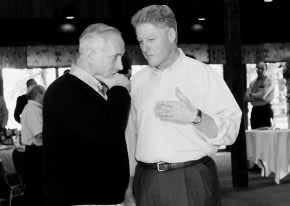
Tucked away today in a library where the three parties met near Queenstown, Maryland, is a plaque commemorating the agreement reached on Oct. 23, 1998, and formally signed at the White House that same day.
Through interviews with those then on the Eastern Shore and the writings of those noteworthy then and now, the timeless ingredients necessary for the plaque’s last word become much clearer.
Etched in Hebrew, English and Arabic on the bottom of the plaque, the final word is: PEACE. A world shattered by destruction would do well to remember the wrestlings through the night that took place in Maryland.
Ahmed Qurie (Abu Ala), a Palestinian negotiator at Wye and later Palestinian prime minister, said in a 2008 book that Israeli-Palestinian relations reached a “high point” after Wye River.
How did they get there — Wye and the history of America
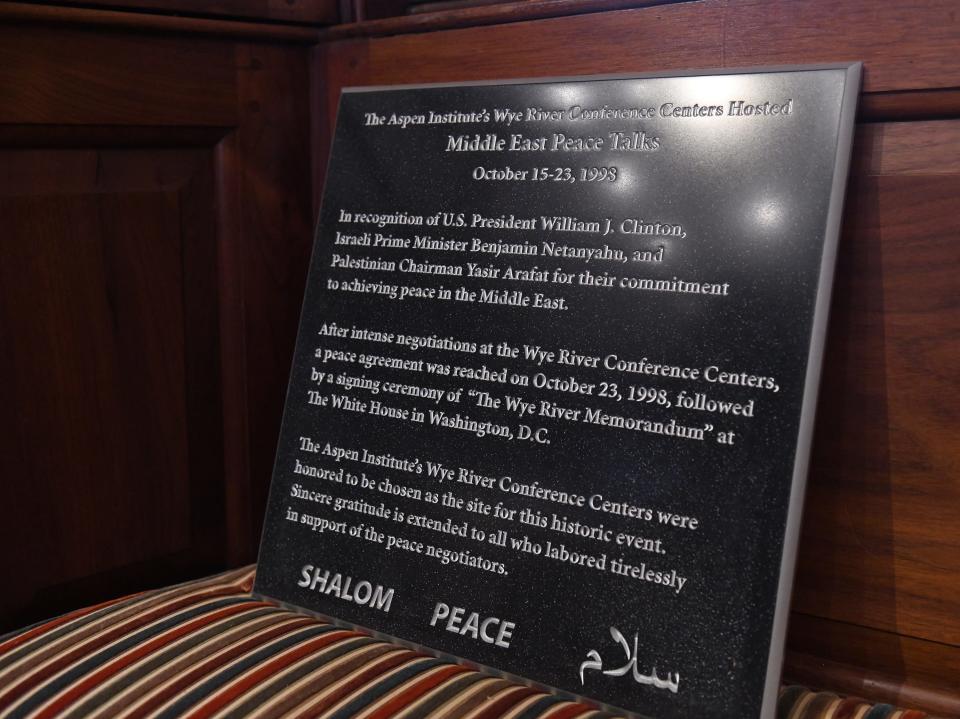
To understand how the Israelis and Palestinians ended up in negotiations at “Wye Plantation,” as it was called during news reports at the time, one must go back to the founding of the country. Not Israel 75 years ago, or a yet to be U.S.-recognized Palestinian state, but the creation of the 13 united states in 1776.
William Paca, a signer of the Declaration of Independence and an early Maryland governor, lived nearby at Wye Island. His son, John, married Juliana Tilghman, also from an influential early American family, and the pair had an over 500-acre wheat and corn plantation worked by dozens of enslaved African Americans in Maryland in the early 1800s.
In the 20th century, the story of the once Paca-owned plantation at Wye had begun to take a more hopeful turn. The property was purchased in 1938 by the heir of the founder of the Corning Glass Works company, Arthur A. Houghton Jr. Houghton, a businessman and onetime curator of rare books at the Library of Congress, sought to restore the property and use it for a more unifying purpose than the Paca’s plantation.
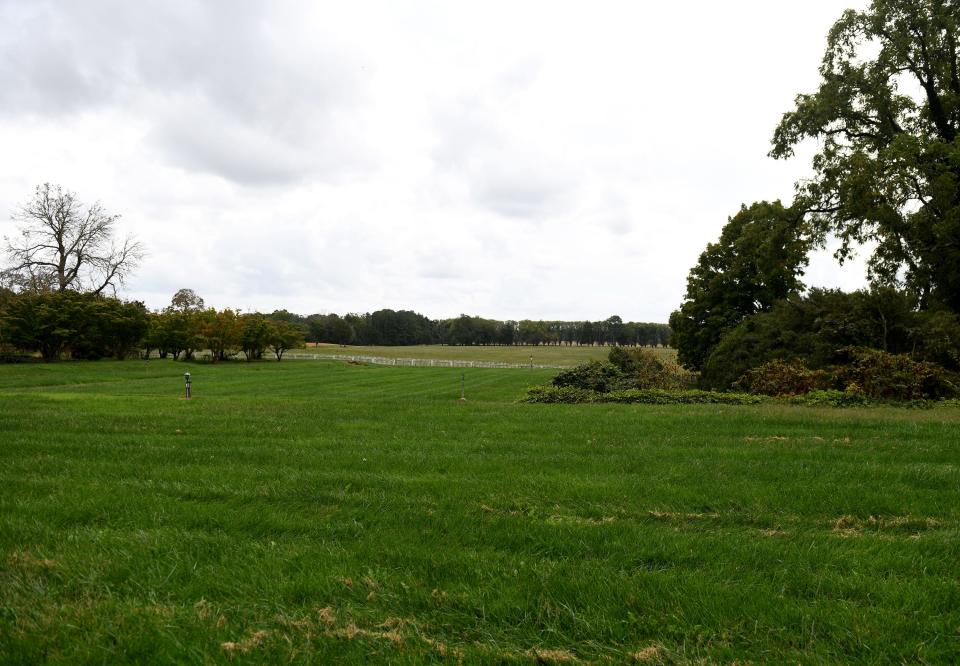
“It was the first integrated camp on the Shore. It was started by my stepfather,” said Jeffrey Horstman, who grew up on the property after his mother married Houghton, in a September interview. (Horstman is the former executive director of the environmental nonprofit ShoreRivers.)
The property for the camp, which began in the ’60s during a tumultuous time for race relations on the Eastern Shore, did not last for that purpose forever, however.
A pair of post-World War II ideas would intertwine and pull the property into the annals of world history.
How did they get there — Wye and the history of Israel
The first creation was the Israeli state in 1948, born out of the question of how to divide Great Britain’s colonial mandate territory between Arabs and Jews after the terrors of the Holocaust and the second world war.
The second creation was the Aspen Institute (originally for Humanistic Studies) in 1949, born out of the question of how to avoid a similar war after the deadliest military conflict in history.
Both post-war creations — the Israeli state and the Institute — intersected after Houghton passed along the Wye property to the Colorado-based Aspen Institute in the late ’70s and early ’80s. Israeli and Syrian diplomats met for talks at the refurbished Aspen Wye River conference centers in late 1995 and early 1996 during Clinton’s first term.
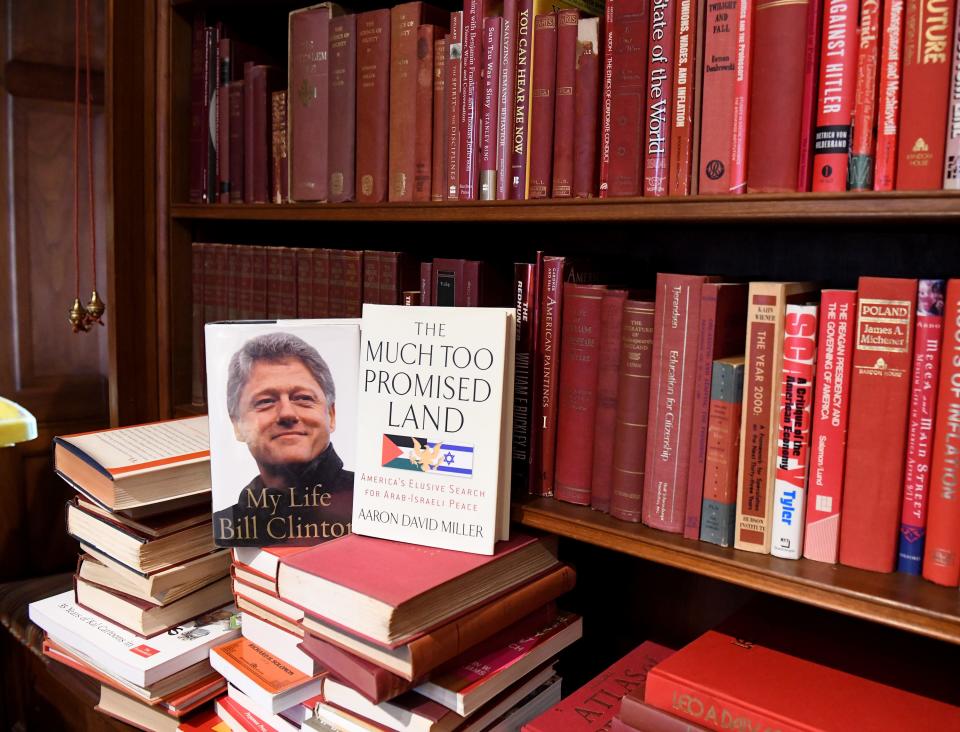
In his book, the former president wrote that by October 1998 U.S. Department of State officials had been “laboring for months to get the peace process back on track.” That process had begun in 1993 after the Israelis and Palestinians agreed to the Oslo Accord, where Israel accepted the Palestinian Liberation Organization, or PLO, as Palestinians’ representative, and the PLO recognized Israel’s right to a peaceful existence and renounced terrorism.
A series of interim steps were necessary towards implementing Oslo, set to expire in May of the next year. And Clinton thought a summit was a “good idea,” while U.S. Secretary of State Madeleine Albright, in her memoir “Madam Secretary,” called the Wye campus “idyllic.”
“You essentially had three secure, isolated but close properties for the three parties: Israelis, the Palestinians, and the Americans,” said Elliot Gerson, executive vice president of the Aspen Institute, in a September interview. He noted the unique characteristics of the property that offered each of the parties their own “beautiful retreat, isolated from the others, but proximate,” which gave the parties a location to come together and find common ground.
Preparation and security were key concerns
Finding that common ground, according to the United States’ top diplomat, was anything but simple.
“There was nothing routine about such an event,” wrote Albright. “To bring the parties along required thousands of hours and hundreds of meetings and phone calls on the part of the President, me, and our team. It was hard, painstaking work.”
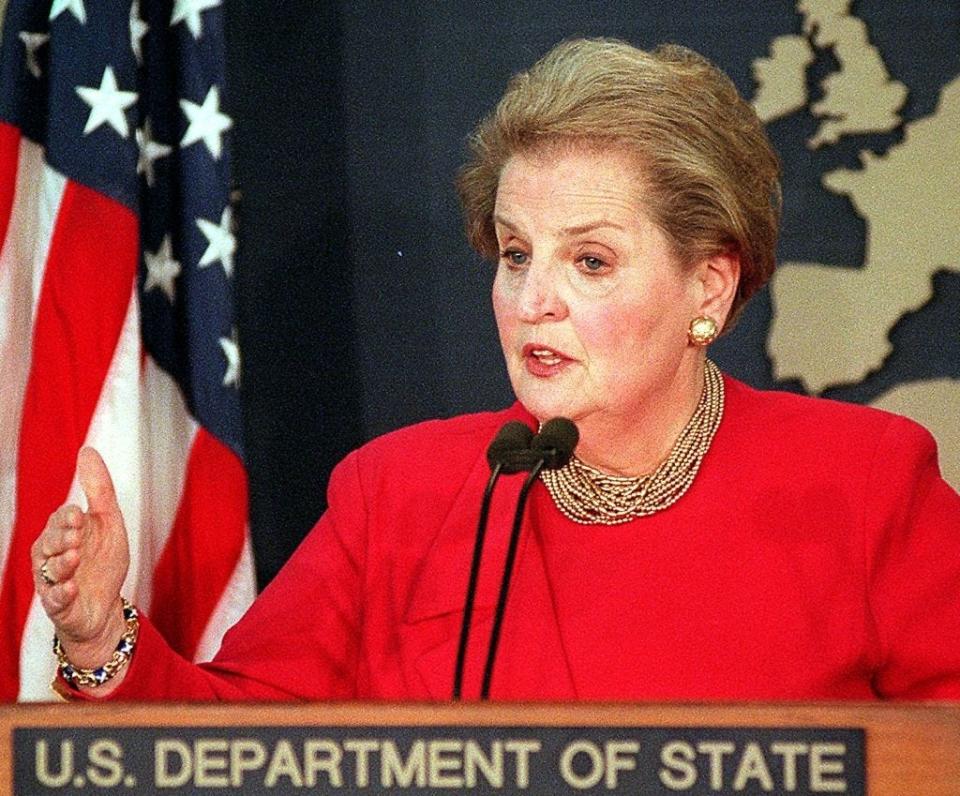
Part of that work was to prepare the Wye site, which functioned as a home to both cattle, overseen by University of Maryland researchers, and conference centers run by Marriott.
“We had less than a month’s notice,” said Cindy Buniski, then a vice president of administration at the Aspen Institute, recalling the rush to move groups that had already been scheduled.
Johnny O’Brien, who lived in a converted barn nearby with his wife, recalls two government officials showing up at his doorstep in coats and ties, asking if his adjacent property could also be used during the talks.
“We have to live here,” O’Brien recalls saying, but he did offer the State Department the use of the tennis guest cottage, about 100 yards from the main home.
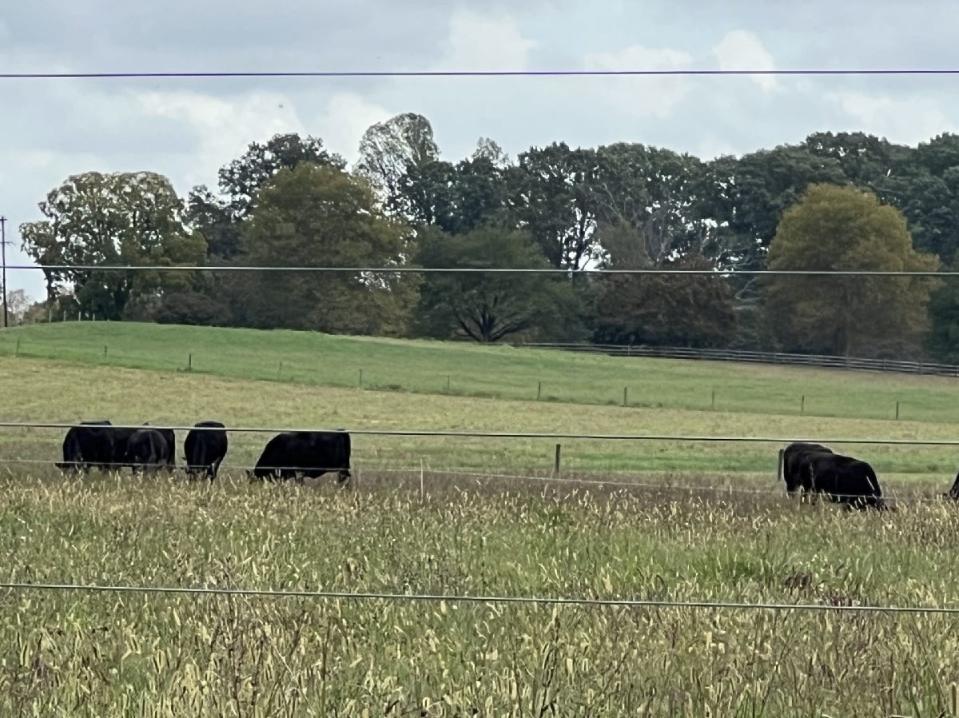
Fiber optic cables were laid for communications around the Wye campus, and a security meeting, including conference center staff, was held that had about 70 people in attendance.
The former U.S. Secretary of State recalled the security being a bit out of place for the farmland setting. The Americans were housed at Wye Woods, about 3 miles across the cattle pastures from where the foreign delegations were staying. The diplomatic security for Albright insisted on the regular downtown Washington, D.C. protocol.
More: State’s solar power increases by the day. Which Maryland counties lead the way?
More: Q&A: Maryland expert talks climate change, wind energy and more before listening sessions
“This meant traveling to various sites in my official limo with flashing lights and a small motorcade,” said Albright, in her memoir. “Out in the middle of nowhere, amidst songbirds and geese, it seemed ridiculous.”
American bodyguards reportedly accompanied a trio of Palestinian negotiators on a shopping trip to a men’s clothing store at a nearby outlet mall.
Decades later, for both the neighbor, O’Brien, and Aspen’s Buniski, it’s the security that stands out.
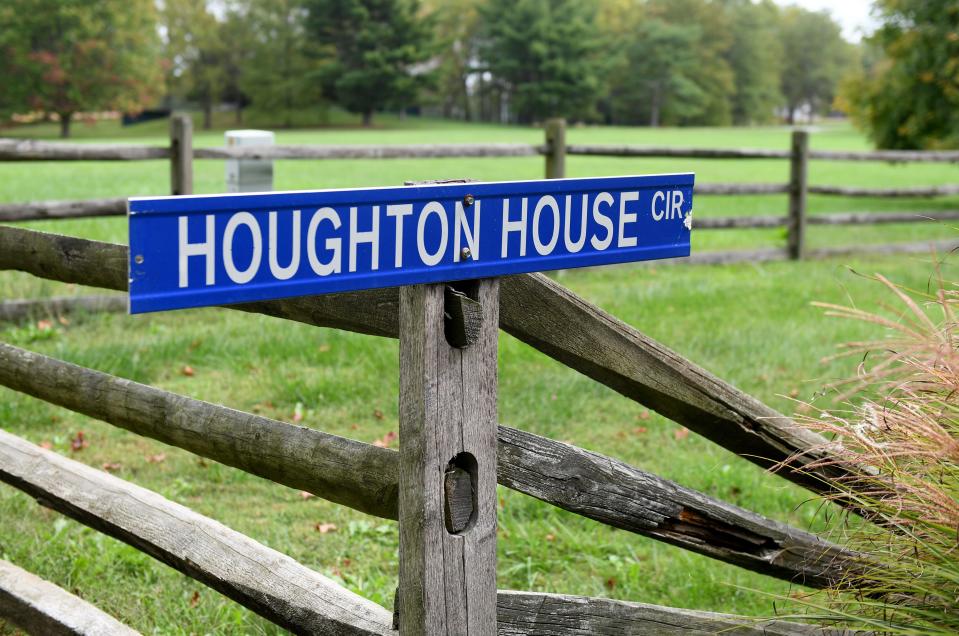
“There were just hundreds (of security personnel) literally crawling on our property, on the Aspen property, out in the water with the Coast Guard,” said O’Brien, who later became president of the Milton Hershey School in Pennsylvania, in an October interview.
Buniski recalls “boats around the entire property,” keeping watch on anyone coming in from the waterways, and multiple security checkpoints on the roads.
Long days and long nights in negotiations
The Israelis stayed in River House with views of the Wye River and a backyard swimming pool. The Palestinians stayed about a quarter mile up the road in the former home of the site’s owner (Houghton House) with its gardens and adjacent library.
And the media, including local, national and international reporters, was cloistered about 10 miles away at Chesapeake College, receiving updates from a U.S. State Department spokesperson.
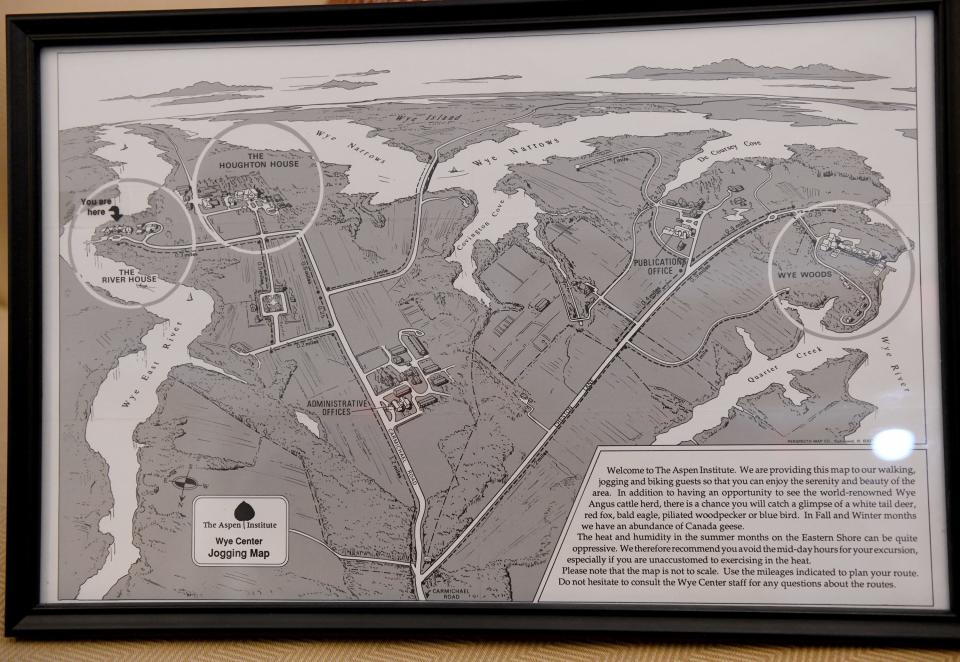
“We did try to create a setting here at Wye to maximize the chance for producing a constructive and pragmatic atmosphere,” said State Department Spokesperson James Rubin, speaking to reporters at the college in Wye Mills on one of the summit’s first days. The news conference was recorded in a C-SPAN video called Middle East Peace Talks.
“What we’ve tried to do is create a balance between having people in the same location — that is, the Wye River facility — but not on top of each other,” said Rubin, in a New York Times article. “There’s a lot of walking that’s done — walking along the river, walking in the woods — between the key negotiators, and time to look out over nice vistas, time to meet in very small rooms.”
This kept conference center staff, a pair of State Department calligraphers on site to set seating arrangements, and those in the kitchen who had to prepare meals (kosher, for members of the Israeli delegation), busy during the summit. The planned four days stretched into more than a week after issues were still being discussed. The staff, including a chef who had recently gotten the job, had to be ready at a moment’s notice.
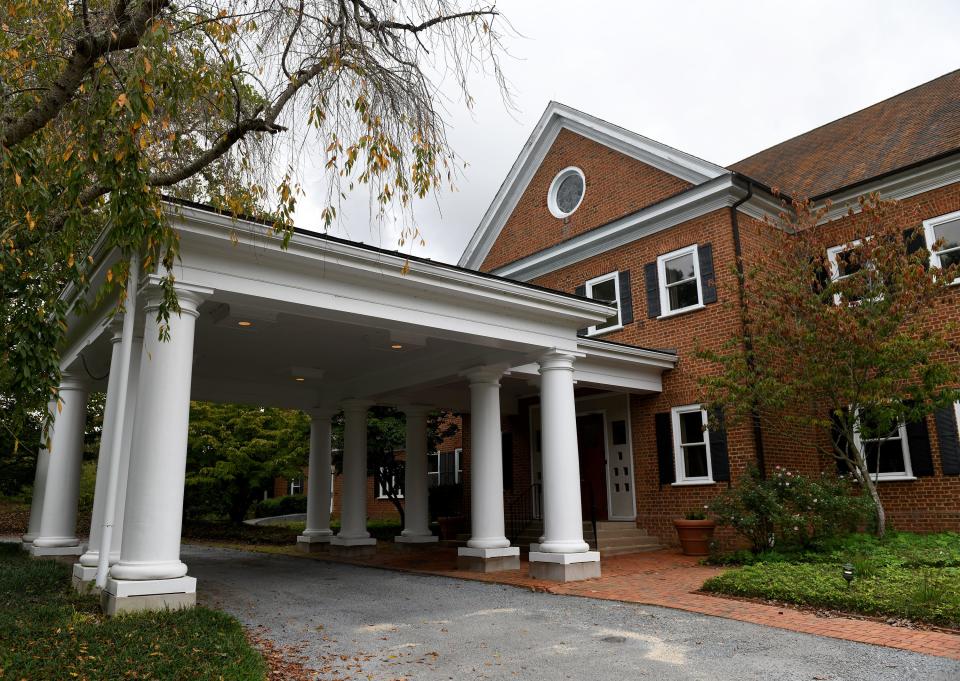
Ray O’Mara, then the general manager at the Aspen Wye River conference center, said his experience with the world leaders was like “living through a movie,” calling the week the “high point of my career,” and noting the staff’s extraordinary efforts.
Clinton was often “up quite late,” recalls Buniski, as late as 3 in the morning.
“One night he ended up in the Wye Woods kitchen, and they ended up making food for him,” she said. “That’s the kind of preparedness that we weren’t used to.”
Serious discussions, still with relevance in Mideast today
Late-night scrambled eggs and the prepared meals were not the primary things on the mind for those encamped at Wye. The main menu item was the land-for-security deal being worked out by the diplomats and heads of state.
On the table were prisoner releases, Israel being asked to cede another 13% of the West Bank to the Palestinians, and Palestinian steps against terrorism, including the removal of dated language in the Palestinian national charter that called for the destruction of Israel.
In his book published last year, Netanyahu recalls in a chapter on “Wye River,” a one-on-one meeting at the summit between himself and Arafat where both men listed their top issues.
“His number one issue was the redesignation of territory,” the Israeli wrote of the Palestinian leader who died in 2004. “My number one issue was security.”
More: Israel and Palestine supporters react to Hamas attacks
More: 'Maryland is leading the nation': Call to serve gets 500 applications for upcoming program
Each country had about 20 people in its diplomatic delegation at Wye, wrote Qurie, the Palestinian negotiator, in his 2008 book “Beyond Oslo, The Struggle for Palestine: Inside the Middle East Peace Process from Rabin’s Death to Camp David.”
Also discussed during the Wye summit, said Qurie, was the opening of an airport in Gaza and the construction of a seaport in the 140-square-mile territory, which is roughly twice the size of Washington, D.C. In 2020, the strip had about three times the population of the U.S. capital.
O’Brien, the neighbor, recalls the principal leaders meeting in the tennis guest cottage, usually after dark, later in the week during the summit.
King of Jordan plays key role in negotiations
The O’Briens’ furniture in the cottage had been cleared out by U.S. government workers, O’Brien recalled, and a bed had been brought in for King Hussein of Jordan. The king, who was in the United States for medical treatment, came to Maryland with his wife, Queen Noor, to help broker peace between his Middle East neighbors.
“It is difficult to describe or overstate the impact Hussein’s presence had on the talks,” President Clinton wrote in 2004. Albright described the ill Hussein as the man “with the least imposing physical presence,” but “the dominating spiritual presence.”
The previous year, a Jordanian soldier had killed seven Israeli schoolgirls, and King Hussein had gone to the homes of the Israelis, knelt with families, and apologized on behalf of his nation.
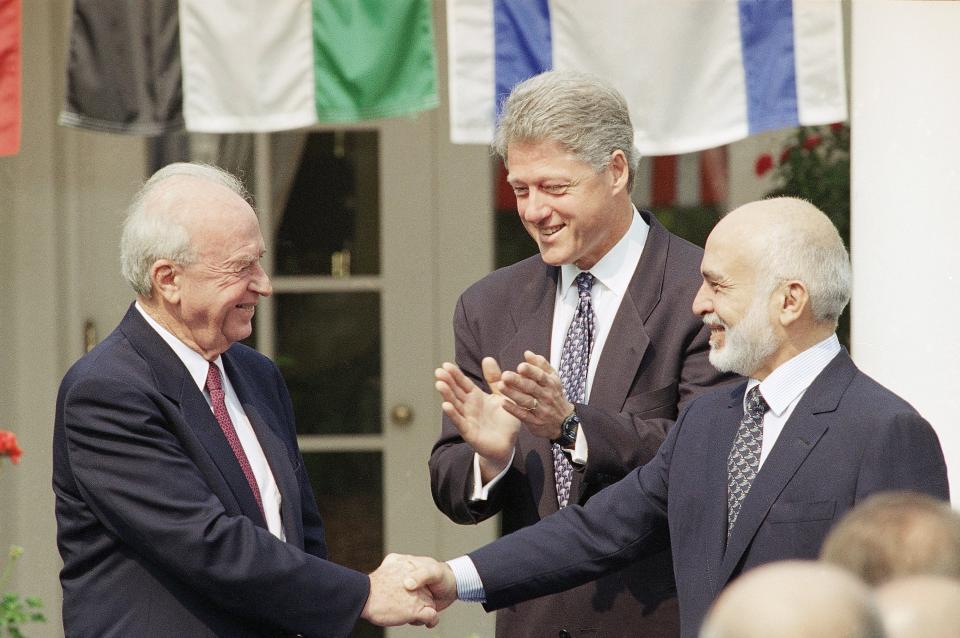
“There was profound substance in that gesture because it showed respect and caring about every human life, Arab or Israeli,” wrote Albright, in her chapter on the Wye talks. “It was only a gesture,” she said, “but it contained within it the solution to all that bedeviled the Middle East.”
Netanyahu, in his book, describes the king’s relationship with his then-7-year-old son, who made a painting for the ailing Hussein that said, “Get well soon.” The Israeli prime minister wrote he was “genuinely moved” by the king’s journey to be there in Maryland.
After eight days at Wye, and a marathon negotiating session into the morning of the ninth day, the parties reached a resolution. It came at about 6:45 a.m., Qurie wrote.
“The Palestinians would get more land, an aiport, a seaport, safe passage between the West Bank and Gaza, a prisoner release, a commitment to restrain Israeli settlement activity, and a fresh influx of economic aid,” Albright wrote in 2003. “The Israelis would get unprecedented security cooperation, the jailing of unwanted Palestinians, repudiation of offensive language in the Palestinian Covenant, and a quick start to final talks.”
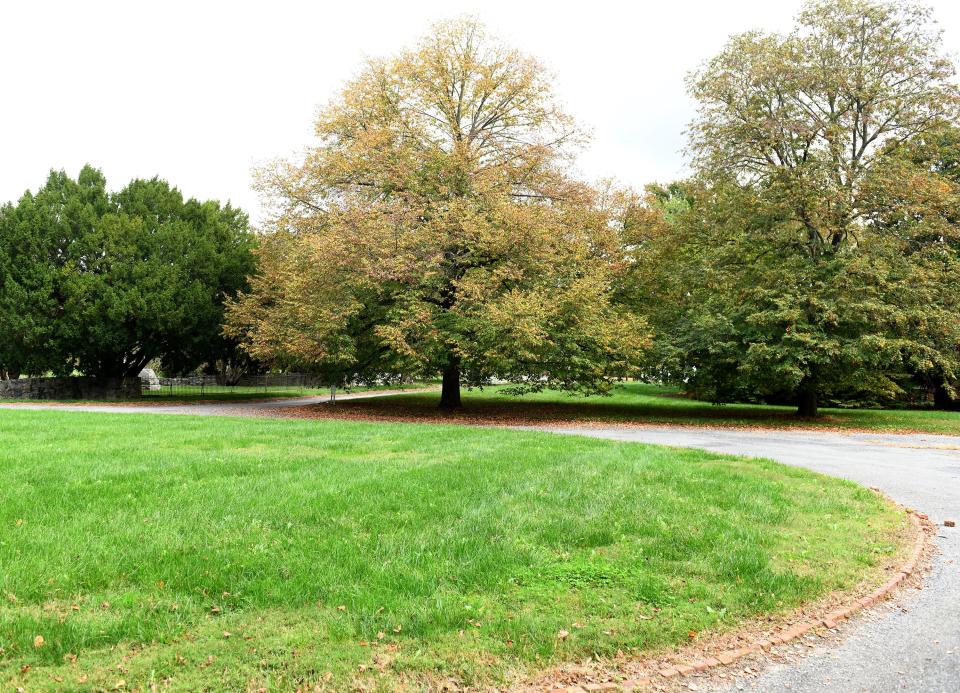
The bags were packed, and the winds whisked the trees on the Wye plantation as top officials flew back by helicopter to the White House on Oct. 23 for a signing ceremony, one which Albright called “among the most moving ever conducted by sleepwalkers.”
Lasting local legacy, world relevance from peace summit
Those involved at Wye, 25 years ago this week, left behind a legacy that continues on the Eastern Shore, and one that still serves as a marker for peace in the Middle East.
The Aspen Institute’s Gerson called what took place during the Wye River summit “an iconic moment in the history of the Eastern Shore.” The institute, downsizing, sold the property a few years ago. Hearkening back to Houghton’s days, a children’s camp again occupies the property under the umbrella of actor Paul Newman’s charities.
Pádraig Barry, the chief strategy officer for the camp, says when he tells people in town where he works, the instant response is: “Oh, that’s the place where the peace treaty happened.”
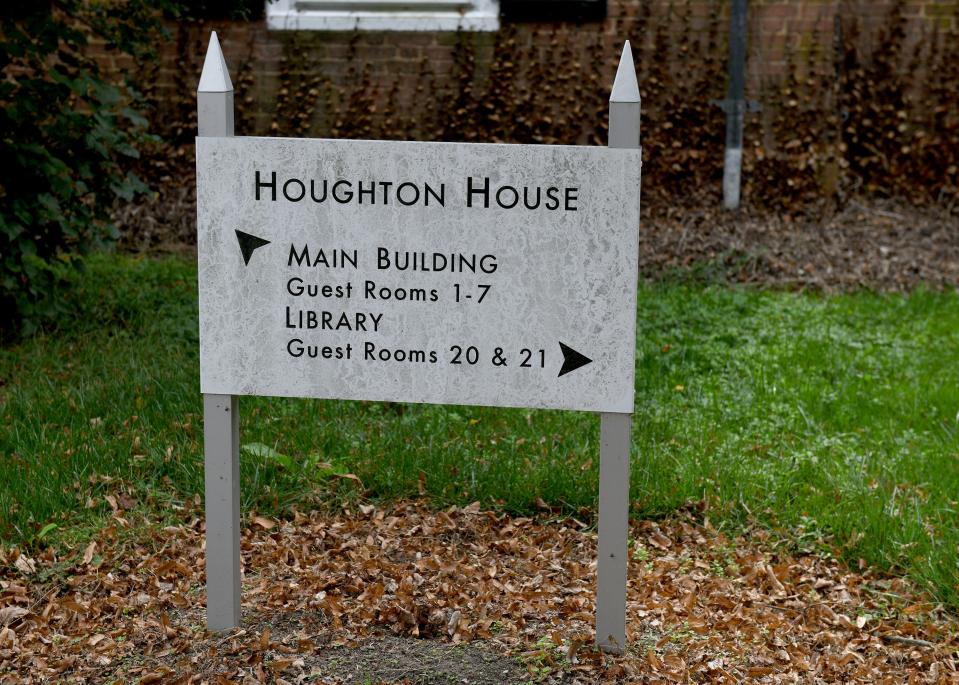
“There’s a pride locally that something so important happened in the backyard here,” said Barry, during an Oct. 6 interview outside Houghton House.
O’Brien, who with his wife, lent their guest cottage towards the effort 25 years ago, sees personal, regional and international significance in those days.
Personally, he recalls meeting Clinton, who came over to thank the couple for their hospitality on one of the negotiation's last days.
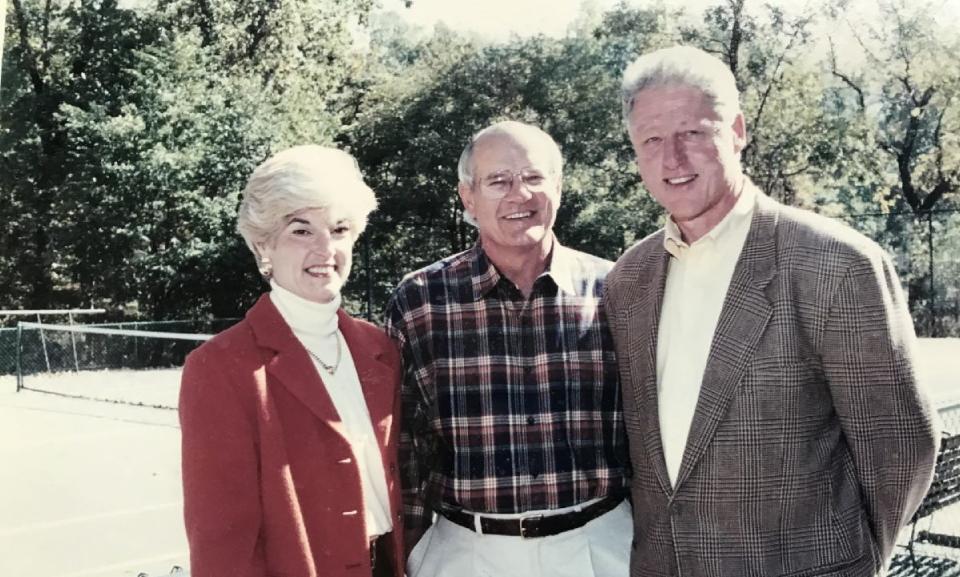
O’Brien and his wife posed for a photo with the president, and still have some of the diplomatic notes that were left behind at the cottage in their scrapbook.
Now living in Easton with his wife, O’Brien said with the “temperament” of the Eastern Shore, the setting at Wye was “ideal” to do something that is important for world peace.
Speaking one day before hundreds in Israel were killed, including more than 20 Americans, by members of the Gaza-headquartered Hamas, an organization designated by the U.S. as a terrorist organization since 1997, O’Brien recalled the leadership of the late 20th century at Wye River.
“Leaders of the world, who in some cases (were) definitely enemies, would sit down through the middle of the night to try to get some accord,” he said.
‘Palestinians and Israelis coming together’
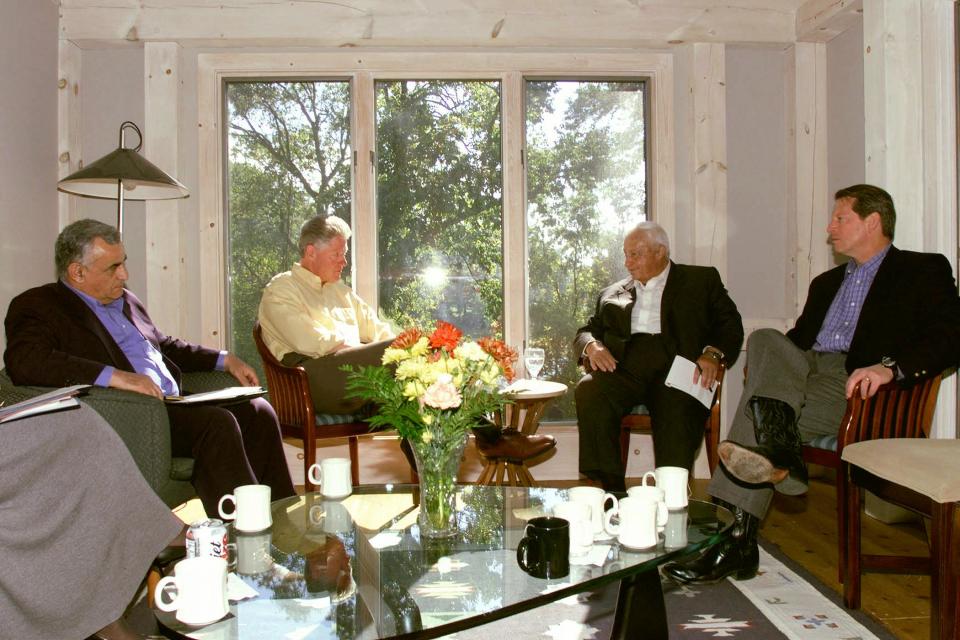
Less than two months after his helicopter took off from the summit near the Wye River, President Clinton again touched down in the effort for Middle East peace — this time at Gaza International Airport, which opened about a month after the Wye summit.
In his book, Qurie, the Palestinian negotiator at the ’98 summit who died earlier this year, called the airport “a direct result of the Wye memorandum.” He writes that the summit “demonstrated the full extent to which America had committed itself to achieve peace between Israel and the Palestinians.”
Albright, the then-U.S. Secretary of State who died last year, recalls what was accomplished at Wye.
“The two sides had been able to reach agreement on important issues by sitting down and dealing directly with one another,” wrote Albright, adding that that had not happened in years. “Netanyahu had moved from opposing the Oslo Process to becoming a part of it."
The Israeli prime minister concludes his chapter on “Wye River” with details of his electoral defeat, which took place the year after he signed the Wye agreement at the White House, in part because of the opposition to the deal from religious parties to his political right.
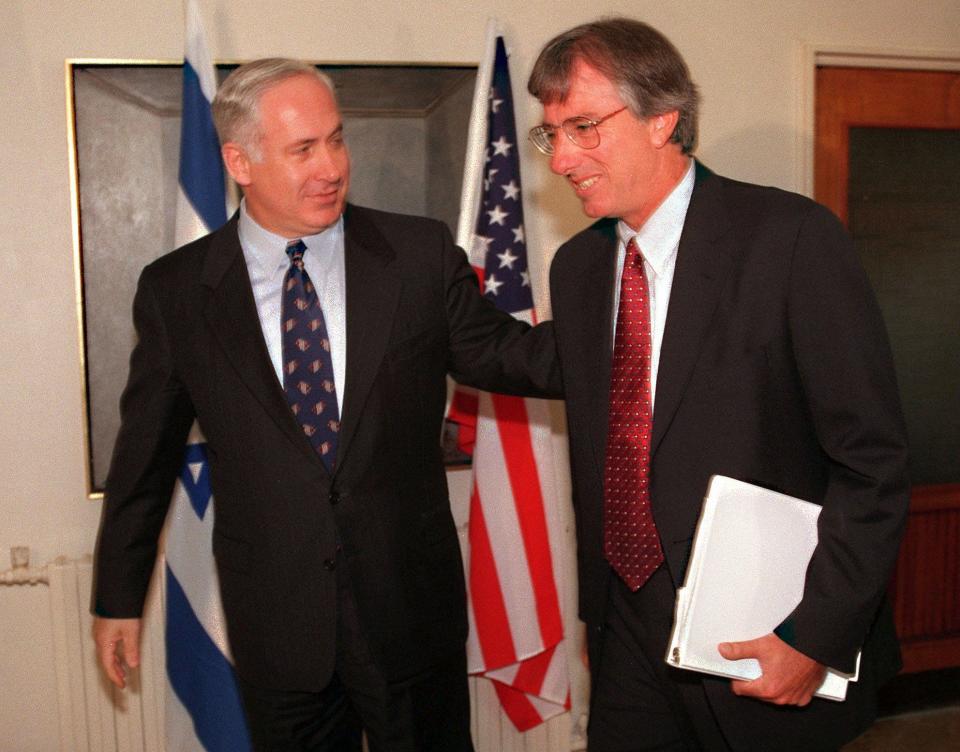
Aaron David Miller, who worked under Albright at the State Department and scouted out the Wye campus with Marriott’s O’Mara, emphasizes the unintended consequences of the deal for the Israeli leader.
“It may well be that Wye’s greatest consequence was to bring about, quite unintentionally, the demise of Netanyahu’s government, which broke apart over the agreement he signed,” wrote Miller in his 2008 book “The Much Too Promised Land.” Netanyahu has returned as prime minister on two more occasions since losing the ’99 election, most recently in December 2022.
Arafat’s successor, Mahmoud Abbas (Abu Mazen), one of the Palestinian negotiators at Wye who was reportedly spotted at the outlet mall then, has reportedly been at odds with the policies of Netanyahu’s government, boycotting a meeting earlier this year with the Israeli government.
And the Gaza airport which Clinton flew to in ’98 was closed by Israel in 2000 and later bombed. It has not had a flight in about 20 years. The Gaza strip has not had an airport since the one, later renamed after Arafat, closed.
The territory has been blockaded for more than 15 years with even the donkeys used to transport goods in short supply before the terror attacks of earlier this month and the ensuing response.
Albright, who sat in between the Palestinian and Israeli leaders in what was once Houghton’s library, recalled the effort of the team, thousands of hours of talks and the hundreds of meetings.
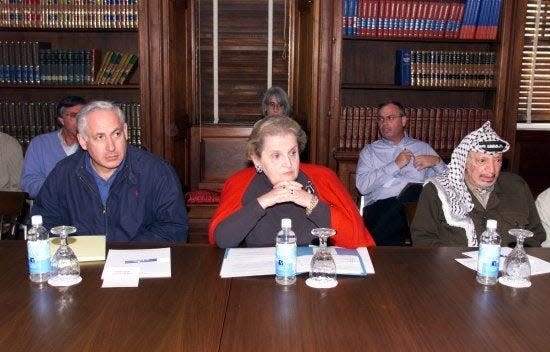
“That is the only way progress toward peace in the Middle East had ever been achieved,” she said. The man she described as “the dominating spiritual presence” among the world leaders, Jordan’s King Hussein, died the year after Wye. His vision, as he stated at the White House signing ceremony for the Wye agreement, remains.
“There has been enough destruction, enough death, enough waste,” he said. “It’s time that together we occupy a place beyond ourselves, our peoples, that is worthy of them under the sun, the descendants of the children of Abraham — Palestinians and Israelis coming together.”
Dwight A. Weingarten is an investigative reporter, covering the Maryland State House and state issues. He can be reached at dweingarten@gannett.com or on Twitter at @DwightWeingart2.
This article originally appeared on Salisbury Daily Times: Maryland's essential role in 1990s Middle East peace deal at Wye River

